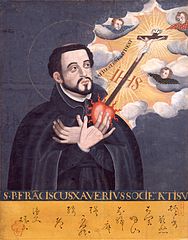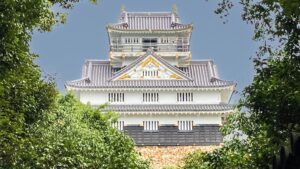Why Was Horyuji Temple Built by Prince Shotoku?
Horyuji Temple, the World's Cultural Heritage Site, is the oldest wooden structure in the world and one of the Buddhist Monuments in the Horyuji area, that has retained its beauty unchanged for almost 1,400 years. It consists of 48 buildings, including the Kondo (Main Hall), the Five-story Pagoda, the Middle Gate, and the East and West Corridors. Horyuji was built in Ikaruga Province along the Yamato River between the Asuka capital and Naniwa Port in Osaka Bay, far from the capital, Asuka. Why did Prince Umayado, known as Prince Shotoku, build such a large temple far from Asuka? He wanted to show its large complex to the Sui Dynasty to make them recognize Japan as a modernized nation.
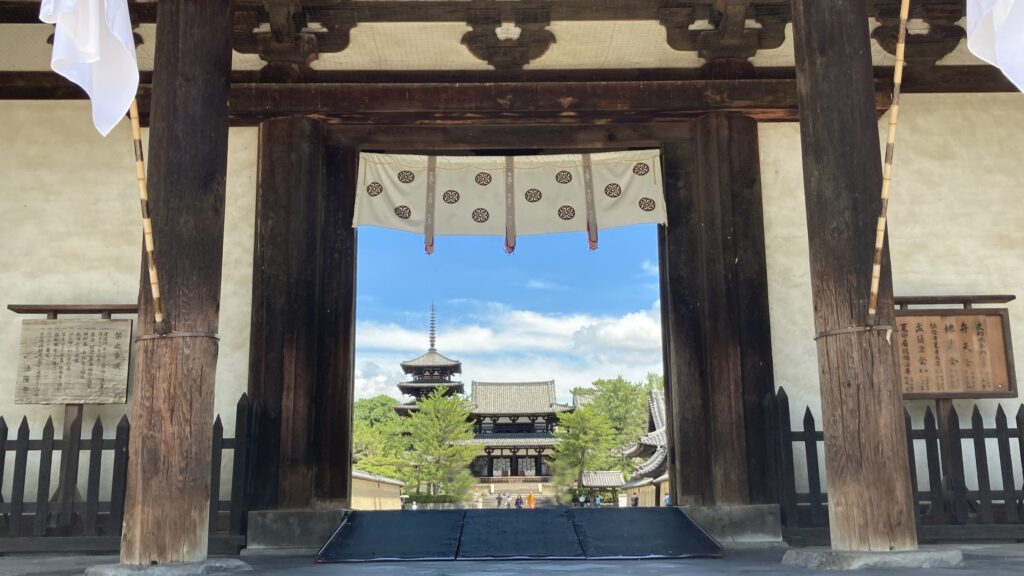
The Entirety of Horyuji is a Sigh-inducing Functional Beauty
The attractivity of Horyuji lies not only in the world's oldest wooden temple but also in its beauty. The high level of architectural technology is still being applied today. Here are some highlights.
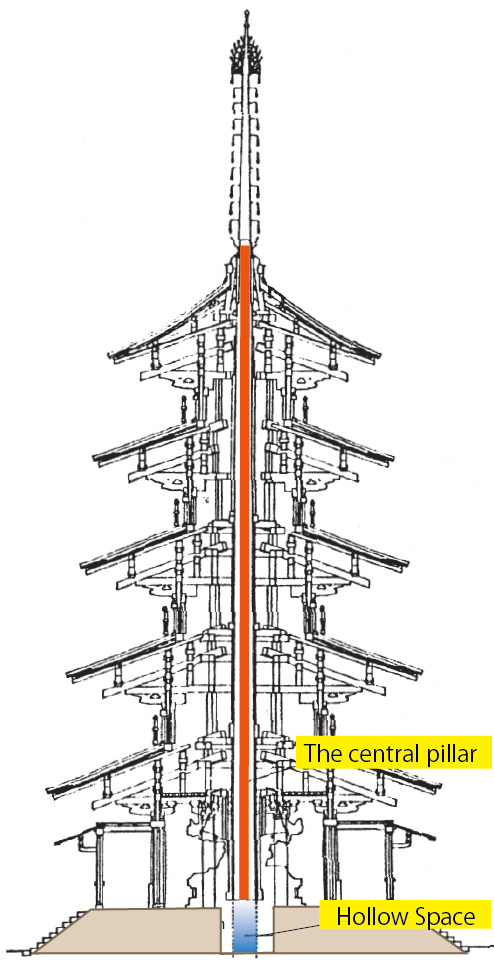
The Five-storied Pagoda becomes narrower toward the top, and the top story is half-size of the bottom, giving the viewer an outstanding sense of stability and beauty. The pagoda has not collapsed in an earthquake since it was established. Once an earthquake occurs, each story of the independent structure sways in opposite directions, as if in a snake dance. Beneath the central pillar, Busshari (Buddhist relics) are enshrined within the Shinso (foundation stone). When the shaking becomes too great, its central pillar acts as a vibration damper, and if the tower itself tilts to the right, the central pillar moves to the left to prevent collapse. In earthquake-prone Japan, the Asuka-era technology is a beautiful piece used in the modern Tokyo Sky Tree Tower.

Let's walk to the East Corridor and look at the ceiling. You can see the Taruki (rafter), their supporting 人-shaped like Sasu (two diagonal struts supporting ridge beam), and the rainbow-like curved Koryo (curved transverse tie beam). The weight of the roof is supported by these parts and the pillars (slightly bulging at the bottom) on the foundation stone. The subtle elegance of the curves creates a beauty that is in distinctive harmony with the whole. Along the corridor, Renjiko (Vertical wooden lattice) creates a sense of beautiful rhythm and leads you forward. This is the ancient beauty created by carpenters in the Asuka period (592-710).
The First Diplomacy with the Sui Dynasty Ended In Failure
From the late 6 century to the early 7 century, tensions within eastern Asian countries increased because the Sui Dynasty unified China in 581 for the first time in about 300 years. Such a great centralized power based on the advanced Ritsu-Ryo code (a legal code system) and its expansion policy, aiming to conquer Koguryo in the northern part of the Korean peninsula, posed an unprecedented threat to the surrounding countries. In response to these moves, Japan sent its first envoy to the Sui Dynasty in 600 to establish diplomatic relations. This failed, however, as the Sui regarded Japan as a barbaric country with a low level of civilization.
Trying To Turn Things Around From The Huge Failure
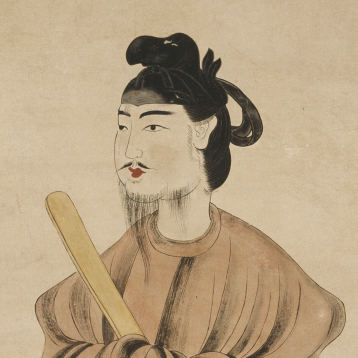
(Source: Colbase)
Reigning Emperor Suiko(554-628, 推古天皇), her regent Prince Umayado (574-622, 厩戸皇子), and a minister Soga Umako (551-626, 蘇我馬子), therefore, took an aggressive and hard-nosed diplomatic strategy, trying to turn things around from the huge failure of the first envoy. They pushed for the establishment of a centralized system based on Buddhism. First, they established the Seventeen-Article Constitution, which stipulated the attitude of government officials in 603, and the Twelve Ranks of the Crown, in which positions were determined by ability and merit, not by family background in 604. The following year, in 605, Prince Umayado moved to Ikaruga Palace from the capital and built the Ikaruga Temple known as Toin and Horyuji Temple known as Saiin in 607 to create an advanced Buddhist city. It was ideally located between the capital, Asuka, and Naniwa Port along the Yamato River flowing into Osaka Bay. The majestic and beautiful structure of Horyuji Temple was an icon of a civilized nation, along with the first Buddhist complex, Asugadera Temple, in the capital of Asuka Province.
Sui's Envoy From The Boat See Horyuji
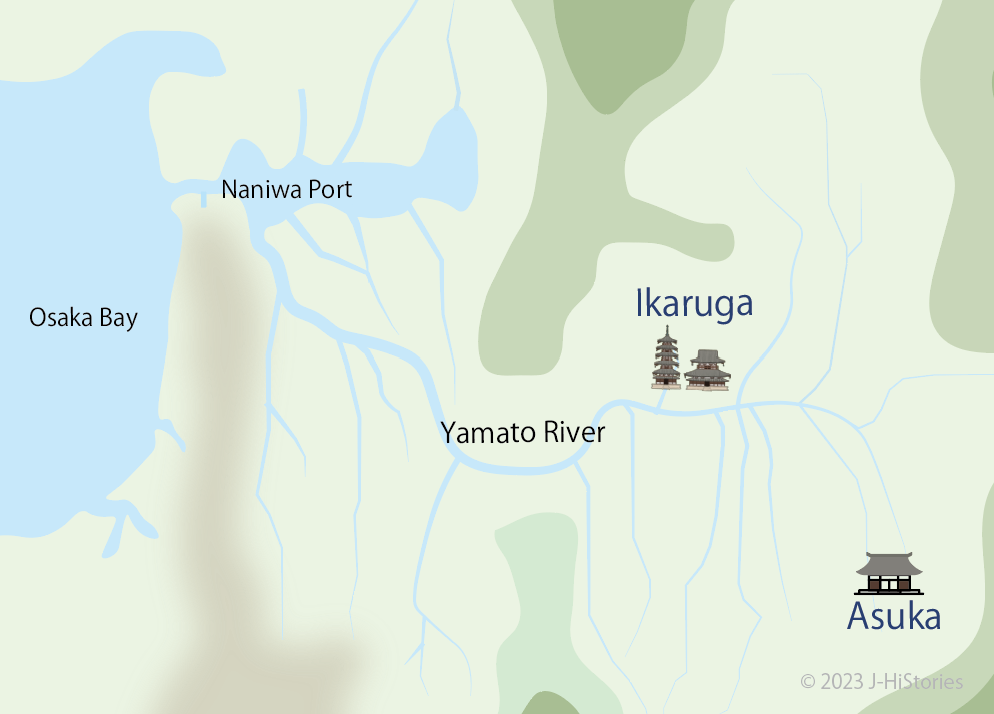
Once Horyuji Temple was built in Ikaruga Province in 607, the long-awaited second envoy was sent. The official message stated: “From the sovereign of the land of the rising sun to the sovereign of the land of the setting sun.” Emperor Sui became extremely angry about this message which clearly described the existence of the “sovereign” in Yamato (Japan), meaning the independent country from Sui beyond its tributary system. However, Sui’s envoy, Hai Seisei, visited Yamato the following year accompanied by twelve other members. They arrived at Naniwa port by boat and then went up the Yamato River to Asuka. They must have seen Ikaruga Temple and Palace on their way, which probably impressed them that Yamato was not a barbaric country but an advanced one. After that, Yamato continued on its course of building a centralized nation under the emperor. At long last, Yamato succeeded in establishing diplomatic relations with the Sui Dynasty.
The Umayado Family Fell but Horyuji Temple Continues to Exist
Around 20 years later after Prince Umayado and his loving wife passed away from disease (probably smallpox) at the age of 49, Ikaruga Palace was burnt down during the battles over succession to the imperial throne, of either Umayado’s son, Prince Yamashiro (?-643, 山背大兄皇子) or another Prince Tamura (later, the 34th Emperor Jomei) in 643. Prince Yamashiro judged the situation hopeless and committed suicide with his wife and children to avoid further conflicts. Here, the Umayado family fell.
Please visit Horyuji Temple and The Gallery of Horyuji Temple at the Tokyo National Museum with the image of the original temple and Ikaruga Palace where Prince Umayado played an important role in transforming the governing system by arranging diplomacy in the Asuka period. Without Prince Umayado, Buddhism might not have taken root in Japan. The Seventeen-Article Constitution says, "Venerably honor the three treasures," and tells us to cherish the three treasures that make us happy. It refers to the enlightened Buddha, Buddhism, and monks. Later, his footprint created several legendary episodes and he was received as a demi-deity as Prince Shotoku (a saint of virtue).
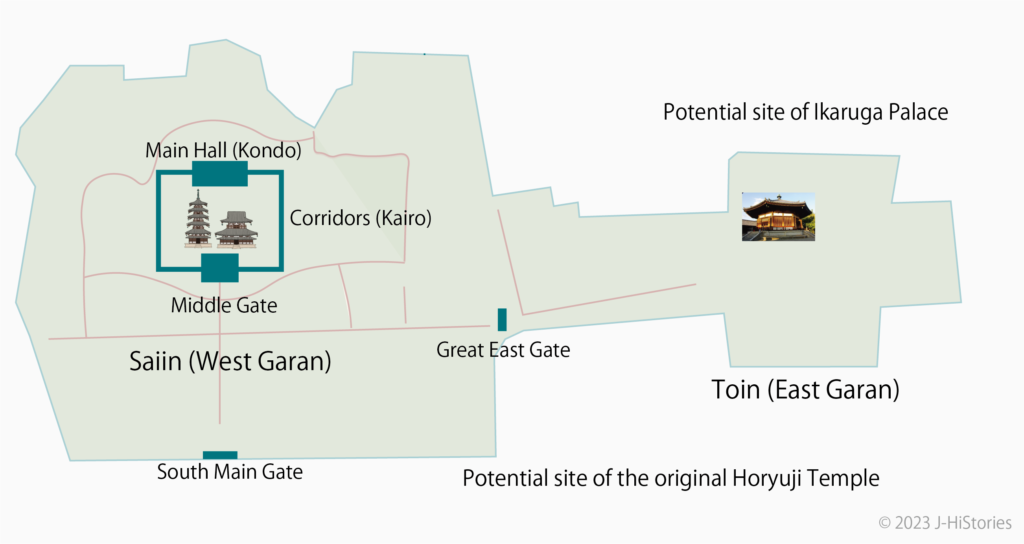
Prince Umayado (Shotoku) Timeline
| 538 | Official introduction of Buddhism from Baekje | - |
| 572 | Soga Umako became a minister. | - |
| 574 | Prince Umayado was born | Age =1 |
| 587 | Soga Umako and Prince Umayado defeated Mononobe Moriya | 14 |
| 589 | Sui Dynasty unified China | - |
| 593 | Reigning Empress Suiko ascended throne | 20 |
| 601 | Prince Umayado built the Ikaruga Palace | 28 |
| 603 | Established a system of "Twelve Ranks of the Crown" | 30 |
| 604 | Established "Seventeen-Article Constitution" | 31 |
| 606 | Asukadera Temple was established | 33 |
| 607 | The second envoy to Sui Daynasty | 34 |
| 622 | Prince Umayato passed away | 49 |
| 626 | Soga Umako passed away | - |
| 628 | Reigning Empress Suiko passed away | - |
Recommendation to visit
Horyuji Temple
- Access: 10 minutes from JR Nara Station on Kansai Main Line bound for Tennoji. Get off at JR Horyuji Station. Take bus #72 bound for "Horyuji-sando(法隆寺参道)” for 8 minutes. Get off at "Horyuji-sando (法隆寺参道)" bus stop, then a few-minute walk.
Tokyo National Museum/The Gallery of Horyuji Treasures
- Access: 10 minutes from Tokyo Station and get off at Ueno Station. A 10-minute walk from JR Ueno Station

